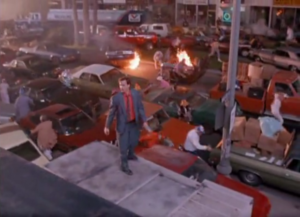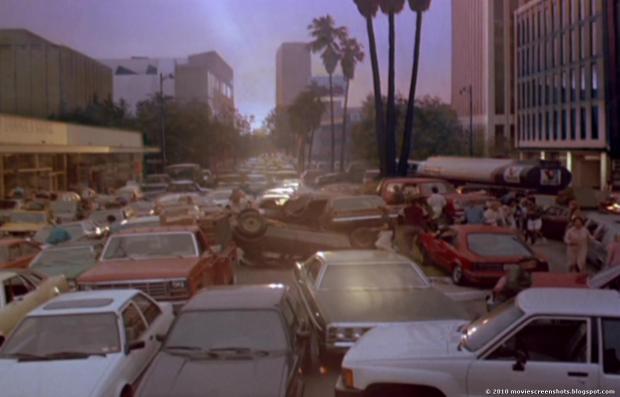In the late 1970s there was a running joke surrounding Francis Ford Coppola’s much anticipated, but disaster-plagued and seemingly endless Vietnam War-as-American Heart of Darkness project, Apocalypse Now. While Michael Cimino’s Heaven’s Gate was already bleeding United Artists of money, Apocalypse Now seemed to bleed time. ‘Apocalypse When?’ peers, press and fans routinely sighed in simultaenous amusement and exasperation.
Today – the day after, it may be noted, Donald Trump has received his first classified national security briefing; as war rages through the entire Middle East, as the state of Louisiana seems doomed to be the first of the lower 48 to sink under water, and California burns in every direction – apocalypse is starting to seem routine and continuous. But in the years just before the global environmental crisis had reached its breaking point, those comparatively innocent years when apocalypse simply seemed to be America’s most durable export, the actuality seemed inextricably linked to its nuclear arsenal. Even then such fears were beginning to subside as Gorbachev’s Perestroika seemed to point a way beyond Cold War East-West animosities. In the meantime, Los Angeles (not to say L.A.’s entire film industry) continued to view the world through that high-concept prism of Los Angeles fashion and lifestyle.
In 1988, the only movie apocalypse most Americans could envision for Los Angeles probably involved fire or earthquake. (Oh goody – at least we got one.) Even those of us who actually lived here were conscious of L.A.’s sense of itself as an urban/suburban laboratory for life-style and fashion. It was as if we’d been living in our own high-concept ‘future’ for so long, we thought we had a clue as to what that future might actually look like. (And do we know any better now? Or actually have the will to make hard choices in altering it?)
In other words, we were deer in the proverbial headlights, lambs ready to bleat blithely to the slaughter. Writer-director Steve De Jarnatt seems to have had a direct line to this hard-wired mentality – in part, I have to assume, because he lived here for the better part of a decade while he was writing and directing other films (and television). De Jarnatt himself seems hard-wired into the furtive obsessions and fascinations of an enormous segment of the American culture (in addition to having an unusual clairvoyance for the dystopian futures that might play out, uh, any day now).
 Miracle Mile manages to be several quintessential films rolled into one. Viewed from the distance of (it seems almost impossible to believe) 28 years, the film is at once a quintessentially Los Angeles movie; a classic (and frequently hilarious) period piece (I don’t think I ever had hair that looked like Mare Winningham’s in the movie, but please don’t tell me if I did); a slightly offbeat yet unrelenting end-of the-world movie; and smashed right into it, the most basic romance – a pre-apocalypse Love Story (just as Love Story itself functioned as a kind of allegory of post-industrialism).
Miracle Mile manages to be several quintessential films rolled into one. Viewed from the distance of (it seems almost impossible to believe) 28 years, the film is at once a quintessentially Los Angeles movie; a classic (and frequently hilarious) period piece (I don’t think I ever had hair that looked like Mare Winningham’s in the movie, but please don’t tell me if I did); a slightly offbeat yet unrelenting end-of the-world movie; and smashed right into it, the most basic romance – a pre-apocalypse Love Story (just as Love Story itself functioned as a kind of allegory of post-industrialism).
The film (as I remember it – although the trailer and a few clips are available on-line) had a sunbleached, Quaalude-hazy look. De Jarnatt knows how to set the mood from the start and sinuously pulls the audience into his fast-unraveling yarn. There are odd foreshadowings here and there – in Anthony Edwards’ alternately nerdy and surreally over-the-top gestures (his performance here – in his soft, almost baby-sensual youth – is itself a kind of curio), the references to dinosaurs and the La Brea Tar Pits, the old Johnie’s Fat Boy coffee shop at Wilshire and Fairfax, from odd birds to old codgers. De Jarnatt understands the well-placed coincidence: a power outtage (at Harry’s (Edwards) hotel) triggers the ‘boy-loses-girl’ phase of the film story, which itself triggers its ‘locks-into-catastrophe’ phase with a fateful ‘wrong-number’ telephone call received by way of the now archaic public telephone booth. Then there’s that quintessential power-suited woman of the 1980s (Denise Crosby) worthy of Charles Ray (he didn’t get to his until 1991 after all) who just happens to be at the coffeeshop counter at 5:00 a.m. – and in touch with the world by way of a now clunky-looking cell phone.
The situation unravels quickly – almost as if in real time: the consequences of a nuclear strike can be depended upon to be swift. Even in 1988, information could be expected to disseminate fairly rapidly; and Los Angeles quickly descends into Day of the Locusts chaos, with traffic predictably, comically choking Wilshire Boulevard. The action on the sidewalks of the instantly dystopic ‘Miracle Mile’ becomes an unbroken chain of looting, violence, and mayhem, uncannily foreshadowing some of the chaos that would be seen as close as Hollywood Boulevard within only four years. De Jarnatt practically lights the bonfire, laying into gun-happy small-time crooks and the dependably heavy-handed LAPD simultaneously. (“Y’all are the ones with the guns.”) It’s a baptism by petrol – the one we’ve had coming for just about ever.
We see what’s under L.A.’s dermatologically perfect skin very quickly. Harry hands Julie (Winningham) a gun for self-defense and she recoils as if alarmed by its mere touch; but within only yards of her new boyfriend is already brandishing it with ferocity. The merely distracted or disaffected are now transformed into the defiant and deranged. Kurt Fuller and Robert Doqui give oddly parallel performances of disaffection turned to lunatic intensity or suicidal fury (the audience practically exulting as Fuller’s character’s eyes melt in the first nuclear flash).
The look of the film alone is remarkable – a consommé of the colors, styles and attitudes of a certain moment: the neon (and simply the resurgence of neon lighting as a decorative element) and pastels; the confectionary color combinations (the chalky blues and coral of Edwards’ post-New Wave suiting); the athletic wear looks only now giving way to ath-leisure; the alternately soft and spiky or angular looks. There’s this sense of an ersatz (or simply failed) sophistication juxtaposed with the oddly earnest or actually innocent. Even amid the mass of the crazed and blasé (really sounds like Los Angeles on any given day), the individual supporting characters stand out distinctively. We’re already coming to know those characters at the coffeeshop counter as we take leave of them – ‘Roger,’ the transvestite, or the doddering old woman with her dog.
More remarkable than even the look of the production, though, is simply the way the film moves. The camera variously loiters upon, saunters and swooshes seamlessly through the characters’ paces, sometimes as if moving in their skin. It’s a kind of real-time suspense – not an easy trick to pull off – and De Jarnatt pushes us – onto our feet, into the catering truck, to hijacked or appropriated police vehicles, into elevators, and finally into our doomed helicopter.
It does not end well. (But then neither did Love Story – remember?) Harry tries to comfort Julie – “I think it’s the insects’ turn.” It’s a nice try – a little realism to offset the non-stop surrealism of, well, life in Los Angeles as we knew it then and for the most part, now.
When I first saw the film in 1988 or 1989, I had certain reservations about certain dangling or unexplained plot/character threads that might otherwise be accepted as short-cuts of a piece with the film’s overall surreal backdrop. Now, in 2016, I find to my alarm, that such threads signal an even greater potential unraveling. Nuclear first strike? Consider the 2003 preemptive invasion of Iraq (might as well have been nuclear). Consider the reality of Trump’s access to the nuclear playbook. We no longer ask, ‘Apocalypse – when?’ The apocalypse is all around us. As for that real or metaphorical ‘helicopter to Tierra del Fuego’? – it’s gonna take a miracle.


